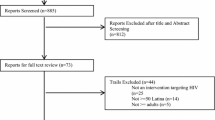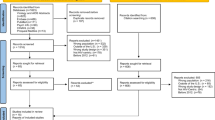Abstract
Latina immigrants living in farmworker communities are a population in need of HIV risk reduction interventions due to their high risk for HIV and their limited access to health care and prevention services. The present study is the first to evaluate the efficacy of SEPA intervention on a cohort of 234 pre-established Latina immigrants living in farmworker communities in South Florida. SEPA is a CDC evidenced-based and Latinx culturally tailored HIV risk reduction intervention. Data were collected through structured interviews at baseline and 6-months post intervention and were analyzed using generalized linear mixed modeling. Results showed that SEPA was effective on increasing condom use during vaginal and anal sex with male partners, self-efficacy for condom use, intentions to negotiate safe sex and HIV-related knowledge from baseline to 6-months post intervention. These findings contribute to the evidence supporting the efficacy of SEPA by confirming previous results and demonstrating the efficacy of this intervention for Latinas of diverse backgrounds.
Similar content being viewed by others

References
CDC: HIV among Latinos. 2019. https://www.cdc.gov/nchhstp/newsroom/docs/factsheets/cdc-hiv-latinos-508.pdf. Accessed 20 May 2019.
CDC: HIV and Hispanics/Latinos. 2018. https://www.cdc.gov/hiv/pdf/group/racialethnic/hispaniclatinos/cdc-hiv-latinos.pdf. Accessed 20 May 2019.
CDC: HIV Among Hispanics/Latinos in the United States and Dependent Areas. 2013. http://www.hivlawandpolicy.org/sites/default/files/HIV Among Hispanics.pdf. Accessed 23 October 2018.
Lee J, Hahm HC. Acculturation and sexual risk behaviors among Latina adolescents transitioning to young adulthood. J Youth Adolesc. 2010;39(4):414–27.
Rojas P, Huang H, Li T, Ravelo G, Sanchez M, Dawson C, Brook J, Kanamori M, De La Rosa M. Sociocultural determinants of risky sexual behaviors among adult Latinas: a longitudinal study of a community-based sample. Int J Environ Res Public Health. 2016;13(11):1164.
Harawa NT, Bingham TA, Cochran SD, Greenland S, Cunningham WE. HIV prevalence among foreign-and US-born clients of public STD clinics. Am J Public Health. 2002;92(12):1958–63.
Dennis AM, Wheeler JB, Valera E, Hightow-Weidman L, Napravnik S, Swygard H, Barrington C, Eron JJ. HIV risk behaviors and sociodemographic features of HIV-infected Latinos residing in a new Latino settlement area in the Southeastern United States. AIDS Care. 2013;25(10):1298–307.
Organista KC, Organista PB. Migrant laborers and AIDS in the United States: a review of the literature. AIDS Educ and Prev. 1997;9(1):83–93.
CDC. HIV infection, syphilis, and tuberculosis screening among migrant farm workers–Florida, 1992. MMWR. 1992;41(39):723.
CDC. HIV seroprevalence in migrant and seasonal farmworkers–North Carolina, 1987. MMWR. 1988;37(34):517.
Shedlin MG, Decena CU, Oliver-Velez D. Initial acculturation and HIV risk among new Hispanic immigrants. J Natl Med Assoc. 2005;97(7 Suppl):32S.
González-Guarda RM, Peragallo N, Urrutia MT, Vasquez EP, Mitrani VB. HIV risks, substance abuse, and intimate partner violence among Hispanic women and their intimate partners. J Assoc Nurses AIDS Care. 2008;19(4):252–66.
Sastre F, Sanchez M, De La Rosa M. Changes in pre-to post-immigration HIV risk behaviors among recent Latino immigrants. AIDS Educ and Prev. 2015;27(1):44–57.
Marín BV. HIV prevention in the Hispanic community: sex, culture, and empowerment. J Transcult Nurs. 2003;14(3):186–92.
Peragallo N, Gonzalez-Guarda RM, McCabe BE, Cianelli R. The efficacy of an HIV risk reduction intervention for Hispanic women. AIDS and Behav. 2012;16(5):1316–26.
Sanchez M, Rojas P, Li T, Ravelo G, Cyrus E, Wang W, Kanamori NP, De La Rosa MR. Evaluating a culturally tailored HIV risk reduction intervention among Latina immigrants in the Farmworker community. World Med Health Policy. 2016;8(3):245–62.
Arcury TA, Sandberg JC, Talton JW, Laurienti PJ, Daniel SS, Quandt SA. Mental health among Latina farmworkers and other employed Latinas in North Carolina. Rural Ment Health. 2018;42(2):89–101.
Kim-Godwin YS, Maume MO, Fox JA. Depression, stress, and intimate partner violence among Latino migrant and seasonal farmworkers in rural Southeastern North Carolina. J Immigr Minor Health. 2014;16(6):1217–24. https://doi.org/10.1007/s10903-014-0007-x.
Blondell SJ, Kitter B, Griffin MP, Durham J. Barriers and facilitators to HIV testing in migrants in high-income countries: a systematic review. AIDS Behav. 2015;19(11):2012–24.
Levy V, Prentiss D, Balmas G, Chen S, Israelski D, Katzenstein D, Page-Shafer K. Factors in the delayed HIV presentation of immigrants in Northern California: implications for voluntary counseling and testing programs. J Immigr Minor Health. 2007;9(1):49–54.
CDC: HIV Surveillance Report, 2017. 2017. https://www.cdc.gov/hiv/pdf/library/reports/surveillance/cdc-hiv-surveillance-report-2017-vol-29.pdf. Accessed 20 May 2019.
United States Census Bureau. QuickFacts Miami-Dade County, Florida. 2010. https://www.census.gov/quickfacts/fact/table/miamidadecountyflorida/POP645217#POP645217. Accessed 20 May 2019.
Safren SA, Traeger L, Skeer MR, O’Cleirigh C, Meade CS, Covahey C, Mayer KH. Testing a social-cognitive model of HIV transmission risk behaviors in HIV-infected MSM with and without depression. Health Psychol. 2010;29(2):215.
Bandura A: Multidimensional scales of perceived academic efficacy. 1990. Unpublished Manuscript.
Bandura A. Self-efficacy in changing societies. New York: Cambridge University Press; 1995.
Peragallo N, DeForge B, O’Campo P, Lee SM, Kim YJ, Cianelli R, Ferrer L. A randomized clinical trial of an HIV-risk-reduction intervention among low-income Latina women. Nurs Res. 2005;54(2):108–18.
Sikkema KJ, Heckman TG, Kelly JA, Anderson ES, Winett RA, Solomon LJ, Wagstaff DA, Roffman RA, Perry MJ, Cargill V. HIV risk behaviors among women living in low-income, inner-city housing developments. Am J Public Health. 1996;86(8):1123–8.
Heckman TG, Kelly JA, Sikkema K, Cargill V, Norman A, Fuqua W, Wagstaff D, Solomon L, Roffman R, Crumble D, Perry M, Winett R, Anderson E, Mercer MB, Hoffman R. HIV risk characteristics of young adult, adult, and older adult women who live in inner-city housing developments: implications for prevention. J Womens Health. 1995;4(4):397–406.
Acknowledgements
This research study was funded by the National Institute on Minority Health and Health Disparities (Grant No. NIMHD- P20 MD002288-10) and National Institute on Alcohol Abuse and Alcoholism (Grant No. K01 AA025992). The content is solely the responsibility of the authors and does not necessarily represent the official views of the National Institutes of Health. The authors would like to acknowledge Maria A. Khalona and all the interviewers for their work on data collection and management, Arnaldo Gonzalez for his editing assistance, the community partner MUJER, Inc. for their support and all women for their participation.
Author information
Authors and Affiliations
Corresponding author
Ethics declarations
Conflict of interest
All authors declare that they have no conflicts of interest and do not have any financial disclosures to report.
Additional information
Publisher's Note
Springer Nature remains neutral with regard to jurisdictional claims in published maps and institutional affiliations.
Rights and permissions
About this article
Cite this article
Rojas, P., Ramírez-Ortiz, D., Wang, W. et al. Testing the Efficacy of an HIV Prevention Intervention Among Latina Immigrants Living in Farmworker Communities in South Florida. J Immigrant Minority Health 22, 661–667 (2020). https://doi.org/10.1007/s10903-019-00923-4
Published:
Issue Date:
DOI: https://doi.org/10.1007/s10903-019-00923-4



